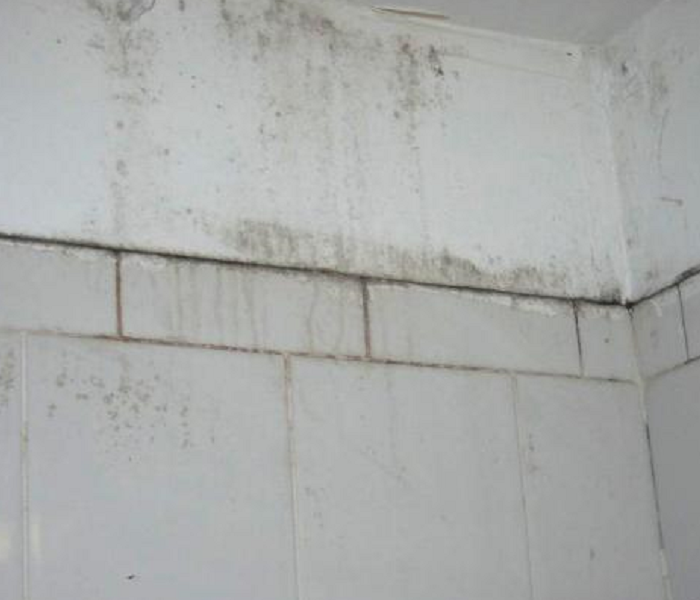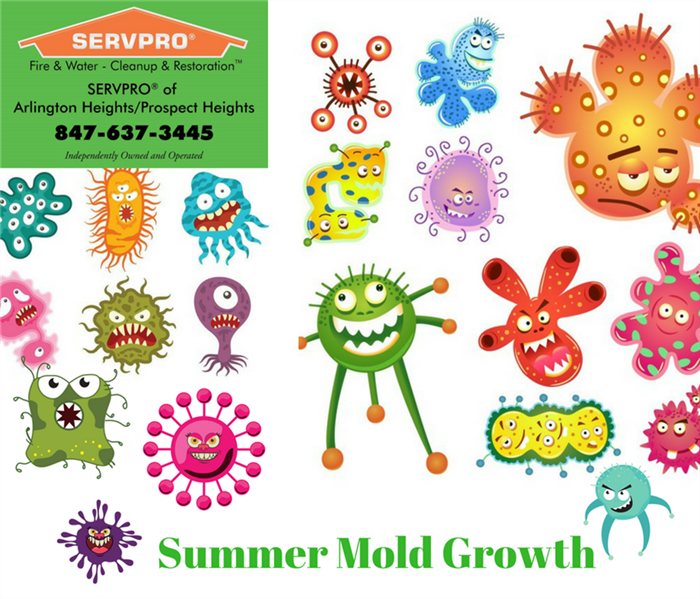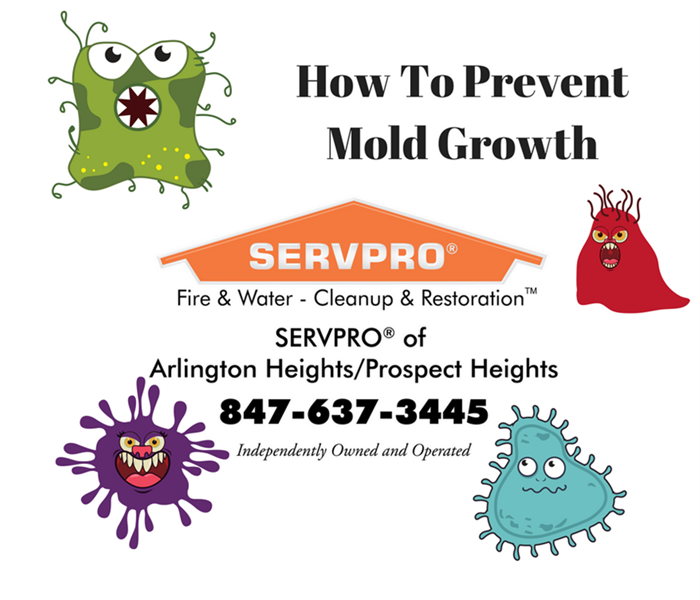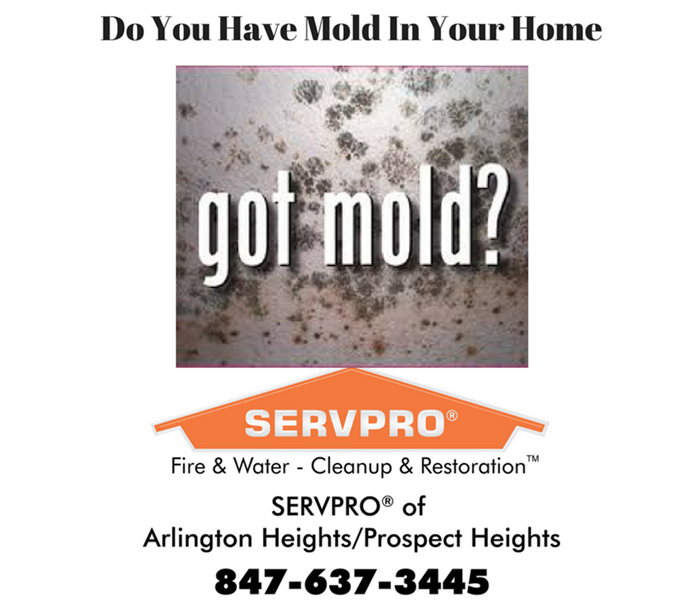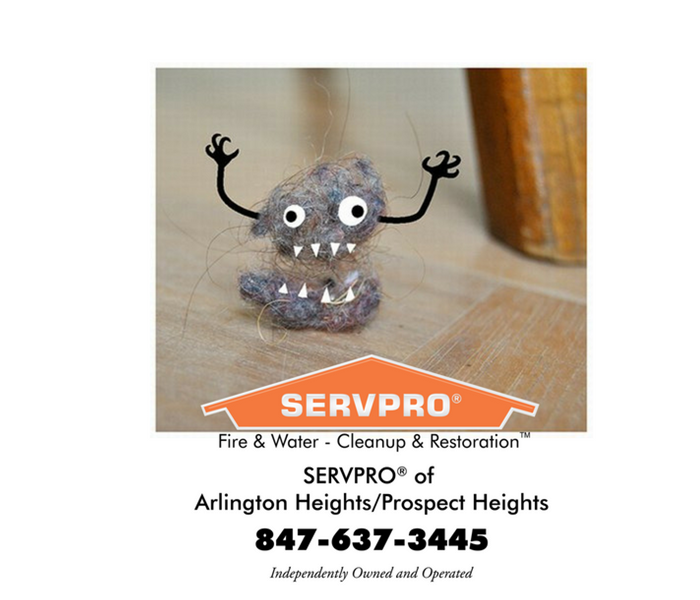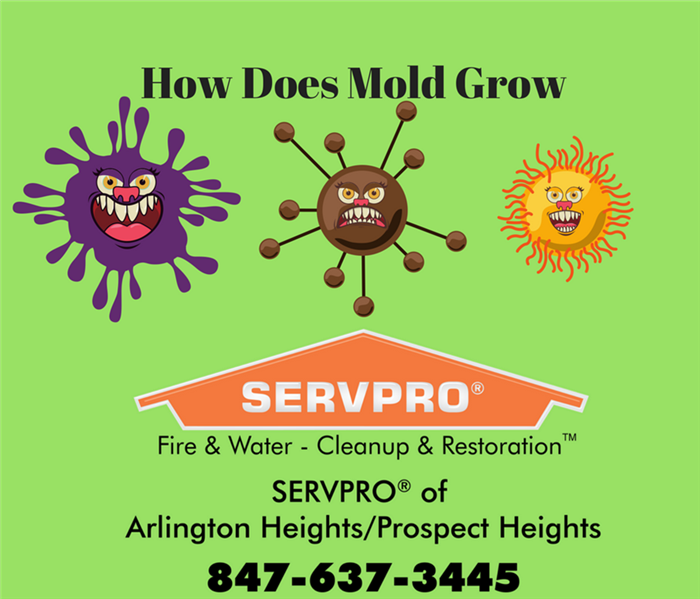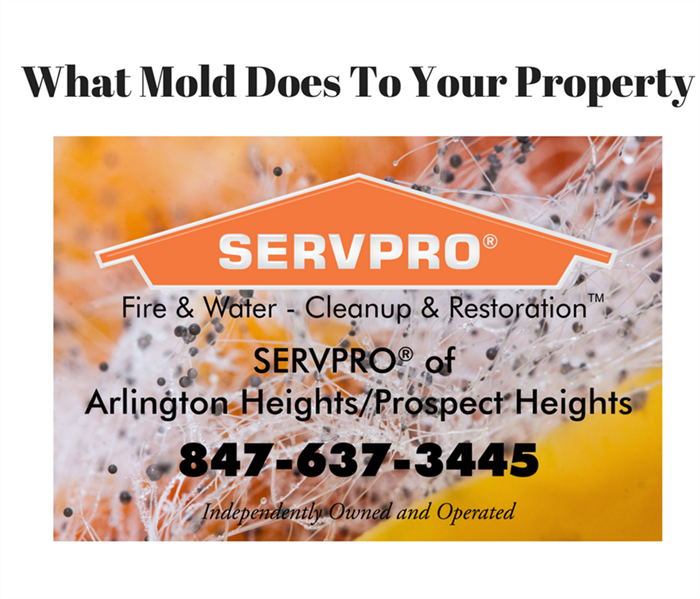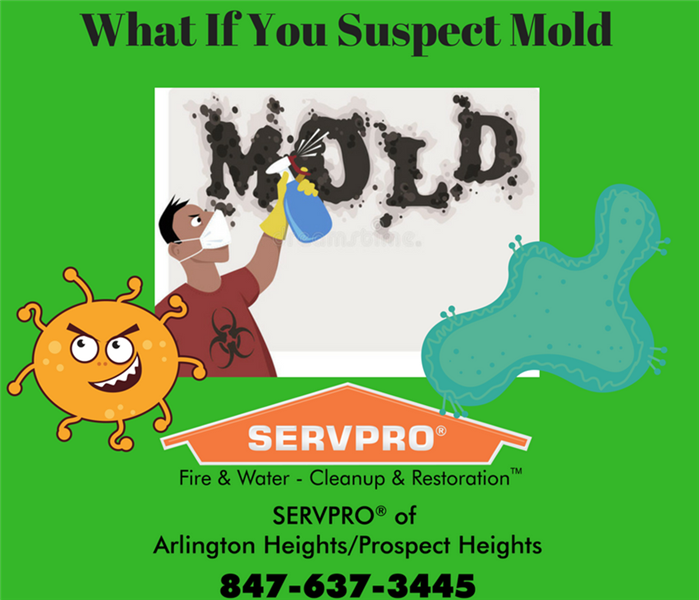Recent Mold Remediation Posts
Rid Your Home of Mold
9/21/2023 (Permalink)
rewrite this "House Mold Can Be Addressed Using Four Cleaning Hacks The sight of mold in your home in Prospect Heights, IL, might make you want to pack up your bags and leave for good, but a small amount of mold growth is no cause for alarm. A widespread, severe mold issue can cause extensive damage to your home and needs to be remediated with the help of a mold cleaning company. However, a minor house mold issue detected early can be addressed using the following four cleaning hacks. 1. Scrub Hard Surfaces With White Vinegar and Baking Soda Vinegar is a very effective natural mold removal solution due to its acidic properties that break down and kill most species of mold. Baking soda, another non-toxic ingredient, absorbs moisture, removes odors, and kills mold. Spray vinegar and baking soda solution and scrub any surfaces that has mold. 2. Soak Fabrics in Hot Water and Oxygen Bleach Fabrics such as clothes, linens or upholstered furniture that remain damp for an extended period time can house moisture-seeking mold. If you can visibly see mold on the fabric, first scrub it off when a brush. Next, soak the fabric in very hot water and oxygen bleach. 3. Lightly Wipe Paper with Hydrogen Peroxide House mold on books and paper can be tricky to clean. First, ensure the paper is completely dry. Next, use a soft paintbrush to brush away any mold you see. Wet a cloth towel with a small amount of hydrogen peroxide, lightly wipe the paper, and allow the page to dry. 4. Clean Tile With Chlorine Bleach and Water If mold has made its way into the grout of your tile floors, you’ll need some chlorine bleach and water. Mix one cup of bleach with a gallon of water and mop it onto your floors. Let it sit for 15 minutes and then scrub. Rid your home of house mold with these four cleaning hacks! If the problem is bigger than you suspected, don’t hesitate to call in a professional mold remediation company. " Addressing House Mold: Four Cleaning Techniques
Dealing with mold in your Prospect Heights, IL home can be distressing, but a small amount of mold growth shouldn't cause immediate panic. However, if you come across a widespread and severe mold issue, it's best to seek assistance from a professional mold cleaning company. For minor mold problems discovered early on, you can try utilizing these four cleaning techniques:
1. Scrub Hard Surfaces Using White Vinegar and Baking Soda
Utilize the acidic properties of white vinegar, which is an effective natural mold removal solution. It breaks down and eliminates most types of mold. Baking soda, on the other hand, absorbs moisture, eliminates odors, and kills mold. Create a solution by combining vinegar and baking soda, then spray it onto surfaces with mold and scrub thoroughly.
2. Soak Fabrics in Hot Water and Oxygen Bleach
Moist fabrics like clothes, linens, or upholstered furniture can become a breeding ground for mold. If you notice visible mold on fabric, start by scrubbing it off with a brush. Then, soak the fabric in hot water mixed with oxygen bleach to eliminate any remaining mold.
3. Gently Wipe Paper Using Hydrogen Peroxide
Cleaning mold from books and paper can be challenging. Begin by ensuring that the paper is completely dry. Next, use a soft paintbrush to brush away any visible mold. Take a cloth towel dampened with a small amount of hydrogen peroxide and lightly wipe the paper, allowing it to dry afterward.
4. Clean Tiles With Chlorine Bleach and Water
If mold has infiltrated the grout of your tile floors, a mixture of chlorine bleach and water will prove effective. Combine one cup of bleach with a gallon of water, mop it onto the floors, and let it sit for 15 minutes. Afterward, scrub the area clean.
Rid Your Home of Mold
Implement these four cleaning hacks to address house mold. However, if the problem exceeds your expectations, don't hesitate to contact a professional mold remediation company for assistance.
Shower Mold Prevention and Removal Tips
9/26/2019 (Permalink)
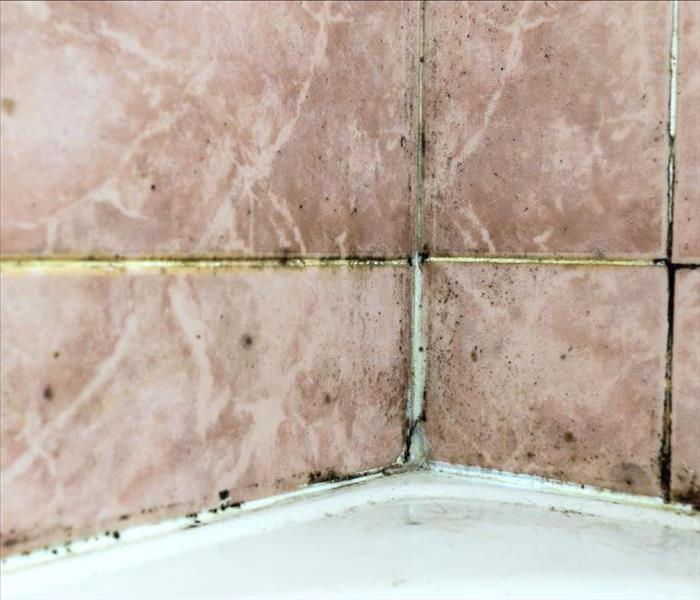 Mold found in shower
Mold found in shower
Shower mold is a common problem for homeowners. Mold spores can exist almost everywhere and can grow rapidly when exposed to the warm, humid, damp conditions of a bathroom. The good news is, there are effective ways to remove mold and prevent it from coming back.
Preventing Mold in Your Shower
A good mold prevention routine can help reduce your chances of a mold problem or prevent an existing issue from recurring.
Here are five tips you can try to reduce your chances of shower mold:
- Reduce the humidity level in your bathroom by running ventilation fans, leaving the door open or opening your bathroom window whenever you are running the shower.
- Repair anything that is leaking water in your bathroom, including leaky faucets, ceiling leaks or leaky windows.
- Avoid standing water in your tub or sink. If your drains are draining slowly, consider cleaning them or calling a plumber.
- Regularly clean your bathroom with anti-mold cleaning products. You should pay special attention to items that are particularly vulnerable to becoming moldy, such as non-slip tub mats and shower curtains.
- Wipe wet surfaces, such as your shower doors and tub, dry after use.
Removing Mold From Your Shower
Attempting to remove black mold yourself can be a dicey proposition. Disturbing mold can cause the spores to spread to the air and be distributed throughout your home, which can lead to a bigger mold problem than you started with.
Another issue with do-it-yourself mold solutions is that some cleaning products remove mold stains, but may not remove all the mold spores, which can lead to mold re-growth. Some cleaning products also don’t work well for non-porous surfaces or can even cause damage to your property. For these reasons, it may be wise to contact a mold remediation specialist in Prospect Heights, IL.
Implementing these tips can help you avoid shower mold or prevent mold from returning. If you’ve already got mold growth, contacting a remediation specialist may be the best way to help you solve the problem.
What You Need To Know About Mold in the HVAC Unit
7/24/2019 (Permalink)
 Clean ducts are mold-free ducts
Clean ducts are mold-free ducts
If you’ve been noticing the smell of mold in your building, but can’t seem to find evidence of black mold anywhere, your HVAC unit could be the culprit. Mold spores naturally exist indoors and out, but in closed office spaces, where the windows rarely open, the spores may collect in the HVAC unit and emit the smell throughout the space.
The Cause of Mold Infestation
Many people may not think of air ducts as the ideal place for mold to hang out, because it shoots out a lot of cold air during the warmer months. However, condensation may form in the unit as it pushes out cold air, which creates a haven for black mold. The mold then gets nutrients from particles in the air that cycle through the HVAC from the office. These include:
- Animal dander
- Indoor dust
- Pollen
Signs of Mold in the HVAC Unit
Because you may not be able to see the mold in the HVAC unit, it may be difficult to tell if mold is the problem without a professional mold inspection. Even so, you may be able to detect mold by the strong mildew smell. People who are sensitive to mold may also suddenly find that they feel most comfortable outside or when windows are open.
Cleaning the Ducts
Clean ducts are mold-free ducts, even though you may need to do this routinely to maintain it. When professionals clean air ducts, they use a biocide that is safe for people to breathe in. Even so, it may be best to schedule a cleaning during days when business is not in operation as the air may need to be turned off during cleaning.
Black mold is a stubborn problem faced by many buildings in Arlington Heights, IL. While there is no foolproof way to prevent in, many property managers and business owners remedy the problem through routine air duct cleanings and using HEPA filters.
4 DIY Cleaning Hacks for a Small Mold Growth Problem in Your Home
5/29/2019 (Permalink)
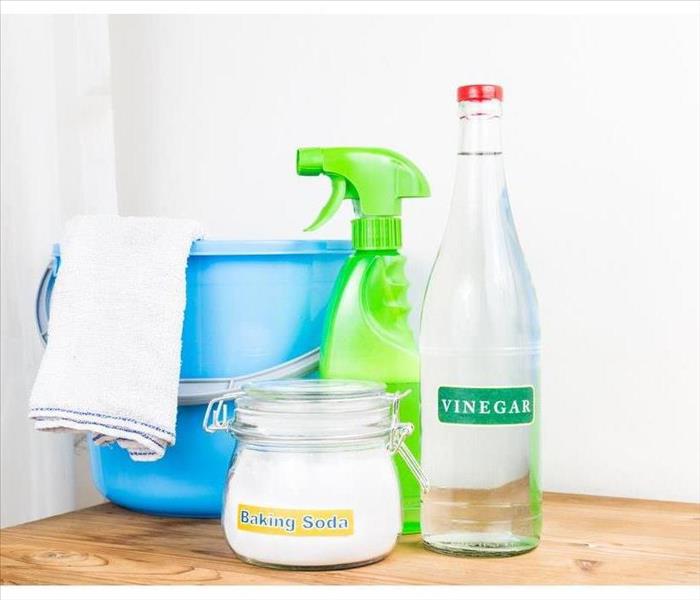 Soak fabrics in hot water and oxygen bleach
Soak fabrics in hot water and oxygen bleach
House Mold Can Be Addressed Using Four Cleaning Hacks
The sight of mold in your home in Prospect Heights, IL, might make you want to pack up your bags and leave for good, but a small amount of mold growth is no cause for alarm. A widespread, severe mold issue can cause extensive damage to your home and needs to be remediated with the help of a mold cleaning company. However, a minor house mold issue detected early can be addressed using the following four cleaning hacks.
1. Scrub Hard Surfaces With White Vinegar and Baking Soda
Vinegar is a very effective natural mold removal solution due to its acidic properties that break down and kill most species of mold. Baking soda, another non-toxic ingredient, absorbs moisture, removes odors, and kills mold. Spray vinegar and baking soda solution and scrub any surfaces that has mold.
2. Soak Fabrics in Hot Water and Oxygen Bleach
Fabrics such as clothes, linens or upholstered furniture that remain damp for an extended period time can house moisture-seeking mold. If you can visibly see mold on the fabric, first scrub it off when a brush. Next, soak the fabric in very hot water and oxygen bleach.
3. Lightly Wipe Paper with Hydrogen Peroxide
House mold on books and paper can be tricky to clean. First, ensure the paper is completely dry. Next, use a soft paintbrush to brush away any mold you see. Wet a cloth towel with a small amount of hydrogen peroxide, lightly wipe the paper, and allow the page to dry.
4. Clean Tile With Chlorine Bleach and Water
If mold has made its way into the grout of your tile floors, you’ll need some chlorine bleach and water. Mix one cup of bleach with a gallon of water and mop it onto your floors. Let it sit for 15 minutes and then scrub.
Rid your home of house mold with these four cleaning hacks! If the problem is bigger than you suspected, don’t hesitate to call in a professional mold remediation company.
Four Ways To Prevent Mold Growth in Your Home
3/18/2019 (Permalink)
 Regular maintenance and cleaning of your home is perhaps the best way to prevent mold.
Regular maintenance and cleaning of your home is perhaps the best way to prevent mold.
Four Ways To Prevent Mold Growth In Your Home
If you have mold growing in your Arlington Heights, IL home, and you don’t know how to deal with it, you might feel stressed and frustrated. However, there are several things that you can do, such as preventing water damage, to keep a growth from forming. Keep these things in mind if you have a fungus problem in your house.
1. Fix Leaks Immediately
Because mold growth happens more quickly in moist environments, you should be sure to repair any leaks in your home as soon as possible. Whether the water is coming from a window, the plumbing or the roof, this is prime breeding space for mold. Even if the leak is small, it can cause enough water damage over time to become a large problem.
2. Keep Humidity Levels Low
If your home has high humidity, then you are more likely to find a mold growth. You can use a dehumidifier or an air conditioner to help keep humidity at an appropriate level.
3. Ventilate Areas That Are Prone to Mold
Active mold prevention is more often required in rooms where you use a lot of water, such as the bathroom, kitchen and laundry room. Keeping these areas ventilated can help. You should also make sure to dry any spaces where water tends to build up.
4. Clean Regularly
Regular maintenance and cleaning of your home is perhaps the best way to prevent mold. If you are cleaning on a regular basis, especially with products that kill mold spores, then the fungus will not have a chance to grow and spread.
While there are many ways that you can prevent mold, it can also be helpful to hire a professional mold remediation service if the problem is too large for you to handle on your own. Particularly if you have extensive water damage, it is a good idea to get outside help. A professional service can remove the mold, as well as repair the damage and prevent it from returning.
Why does mold grow in my home?
8/11/2018 (Permalink)
Mold spores need three things to grow into mold: nutrients, cellulose (the cell wall of green plants) is a common food for indoor spores, and moisture. To begin the decaying process caused by mold; time -mold growth begins from 24 hours to 10 days after the provision of growing conditions.
Molds are found everywhere, and can grow on almost any substance when moisture is present. They reproduce by spores, which are carried by air currents. When spores land on a moist surface suitable for life, they begin to grow.
Common building materials are capable of sustaining mold growth. Mold growth in an indoor environment is typically related to water or moisture and may be caused by incomplete drying of flooring materials. Flooding, leaky roofs, building-maintenance or indoor-plumbing problems can lead to interior mold growth. Water vapor commonly condenses on surfaces cooler than the moisture-laden air, enabling mold to flourish. This moisture vapor passes through walls and ceilings, typically condensing during the winter in climates with a long heating season. Floors over crawl spaces and basements, without vapor barriers or with dirt floors, are mold-prone.
Significant mold growth requires moisture and food sources and a substrate capable of sustaining growth. Common building materials, such as plywood, drywall, furring strips, carpets, and carpet padding provide food for mold. In carpet, invisible dust and cellulose are food sources. After water damage to a building, mold grows in walls and then becomes dormant until subsequent high humidity; suitable conditions reactivate mold. Mycotoxin levels are higher in buildings which have had a water incident.
If you suspect, that you have mold growing in your home or business, Call SERVPRO of Arlington Heights/Prospect Heights today at 847-637-3445. We will help you make it “Like it never even happened.”
Summer Mold Growth
7/10/2018 (Permalink)
In general, mold grows well within the same temperature range that makes us feel comfortable – about 60 to 80 degrees. When warm, moist air comes into contact with cold surfaces, it can create condensation, since the cooler air can't hold as much moisture. Sometimes, humidity or dampness, or water vapor in the air can supply enough moisture for mold growth. Indoor relative humidity should be kept below 60 percent. Ideally humidity should be kept between 30 percent and 50 percent, if possible.
In the summer, air conditioning can de-humidify indoor space. However, if the system is too large or too small for the space it serves, the cooling system can create high humidity by cooling without removing water vapor. A properly sized and maintained system will dehumidify and cool a building. Learn more about the role of heating, ventilation and air conditioning HVAC systems in indoor environmental quality.
When there are cold surfaces in a building, water vapor can condense on those surfaces, just as water condenses on the outside of a glass of ice water. Insulation of exterior walls can prevent condensation and mold growth during the winter.
You should always be mindful of indoor sources of water vapor that can be problematic. Clothes dryers must be vented to the outdoors. Unvented gas or kerosene space heaters can generate enormous amounts of water vapor (as well as other air contaminants), and should be used sparingly and never as a primary heat source. Always run the bathroom exhaust fan when showering or bathing, and make sure the vent is exhausted to outdoors. A properly vented kitchen exhaust fan can remove steam created during cooking.
If you find you have mold growth in your home give SERVPRO of Arlington Heights/Prospect Heights a call at 847-637-3445. We will make it “Like it never even happened.”
Mold: What You Need To Know
6/28/2018 (Permalink)
According to the EPA the ten things you should know about mold:
1. Mold can cause health effects to people.
2. There is no practical way to eliminate all mold and mold spores in the indoor environment; the way to control indoor mold growth is to control moisture.
3. If mold is a problem in your home or school, you must clean up the mold and eliminate sources of moisture.
4. Fix the source of the water problem or leak to prevent mold growth.
5. Reduce indoor humidity (to 30-60%) to decrease mold growth by:
• Venting bathrooms, dryers and other moisture-generating sources to the outside
• Using air conditioners and de-humidifiers
• Increasing ventilation
• Using exhaust fans whenever cooking, dish washing and cleaning
6. Clean and dry any damp or wet building materials and furnishings within 24-48 hours to prevent mold growth.
7. Prevent condensation: Reduce the potential for condensation on cold surfaces (i.e., windows, piping, exterior walls, roof, or floors) by adding insulation.
8. Molds can be found almost anywhere; they can grow on virtually any substance, providing moisture is present. There are molds that can grow on wood, paper, carpet, and foods.
It is the water that you do not see that causes the most damage to your home and business. Water contains bacteria that can cause mold, rot, and other unseen damage.
In order to control mold, you have to control the moisture in a building. Once you detect water, acting promptly is the key to controlling mold. You need to get the water infiltration stopped and cleaned within 24-48 hours.
The IICRC (Institute of Inspection, Cleaning and Restoration Certification) gives several good tips on how to prevent mold.
• Repairing plumbing leaks and leaks in the building structure as soon as possible.
• Looking for condensation and wet spots. Fix source(s) of moisture incursion problem(s) as soon as possible.
• Preventing moisture from condensing by increasing surface temperature or reducing the moisture level in the air (humidity). To increase surface temperature, insulate or increase air circulation. To reduce the moisture level in the air, repair leaks, increase ventilation (if outside air is cold and dry), or dehumidify (if outdoor air is warm and humid).
• Keeping HVAC drip pans clean, flowing properly, and unobstructed.
• Performing regularly scheduled building/ HVAC inspections and maintenance, including filter changes.
• Maintaining indoor relative humidity below 70% (25 - 60%, if possible).
• Venting moisture-generating appliances, such as dryers, to the outside where possible.
• Venting kitchens (cooking areas) and bathrooms according to local code requirements.
• Cleaning and drying wet or damp spots as soon as possible, but no more than 48 hours after discovery.
• Providing adequate drainage around buildings and sloping the ground away from building foundations. Follow all local building codes.
• Pinpointing areas where leaks have occurred, identifying the causes, and taking preventive action to ensure that they do not reoccur.
It is impossible to rid your home or business of mold spores. Some mold spores can travel through the air and in dust, however if there is no moisture present, there can be no mold growth. Remember, if you clean up the mold, but do not fix the water problem, then the mold problem will continue to come back. That is where SERVPRO is here to help. Should you suspect mold in your home or business, contact our office at 847-637-3445.
How To Prevent Mold Growth
6/13/2018 (Permalink)
Where ever there is moisture, there will be mold growth. Thanks to these tips from the CDC, we can keep mold from growing out of control in our homes.
1) Keep humidity levels as low as you can—no higher than 50%–all day long. An air conditioner or dehumidifier will help you keep the level low. Bear in mind that humidity levels change over the course of a day with changes in the moisture in the air and the air temperature, so you will need to check the humidity levels more than once a day
2) Be sure that your home has enough ventilation. Use exhaust fans that vent outside your home in the kitchen and bathroom. Make sure that your clothes dryer vents outside your home.
3) Fix any leaks in your home’s roof, walls, or plumbing so mold does not have moisture to grow.
4) Clean up and dry out your home thoroughly and quickly (within 24–48 hours) after flooding.
5) Add mold inhibitors to paints before painting
6) Clean bathrooms with mold-killing products
7) Remove or replace carpets and upholstery that have been soaked and cannot be dried promptly. Consider not using carpet in rooms or areas like bathrooms or basements that may have a lot of moisture.
If you suspect you have mold growing on your home, SERVPRO of Arlington Heights/Prospect Heights is here to help. Give us a call at 847-637-3445 and set an appointment for us to come and look at your home or business to assess the suspected mold damage.
Does Your Home Have A Mold Problem?
6/12/2018 (Permalink)
Microscopic mold spores naturally occur almost everywhere, both outdoors and indoors. This makes it impossible to remove all mold from a home or business. Therefore, mold remediation reduces the mold spore count back to its natural or baseline level. Some restoration businesses advertise “mold removal” and even guarantee to remove all mold, which is a fallacy. Consider the following mold facts:
- Mold is present almost everywhere, indoors and outdoors.
- Mold spores are microscopic and float along in the air and may enter your home through windows, doors, or AC/heating systems or even hitch a ride indoors on your clothing or a pet.
- Mold spores thrive on moisture. Mold spores can quickly grow into colonies when exposed to water. These colonies may produce allergens and irritants.
- Before mold remediation can begin, any sources of water or moisture must be addressed. Otherwise, the mold may return.
- Mold often produces a strong, musty odor and can lead you to possible mold problem areas.
- Even higher-than-normal indoor humidity can support mold growth. Keep indoor humidity below 45 percent.
If your home or business has a mold problem, we can inspect and assess your property and use our specialized training, equipment, and expertise to remediate your mold infestation.
If You See Signs of Mold, Call Us Today – (847) 637-3445
Dust that accumulates in your air ducts can lead to microbial growth
6/7/2018 (Permalink)
Many sections of your heating and cooling system may not be accessible for a visible inspection, and mold can easily exist in your ducts. You should be aware that although a substance may look like mold, a positive determination of whether it is mold or not can be made only by an expert and may require laboratory analysis for final confirmation. If you have insulated air ducts and the insulation gets wet or moldy it cannot be effectively cleaned and should be removed and replaced.
You should consider having the air ducts in your home cleaned if:
- There is substantial visible mold growth inside hard surface (e.g., sheet metal) ducts or on other components of your heating and cooling system.
- Ducts are infested with vermin, e.g. (rodents or insects).
- Ducts are clogged with excessive amounts of dust and debris and/or particles are actually released into the home from your supply registers.
If you do decide to have your air ducts cleaned, give SERVPRO of Arlington Heights/Prospect Heights a call at 847-637-3445, and we will be happy to come to your home or business to clean out the ducts for you.
How Does Mold Grow
6/1/2018 (Permalink)
According to the Healthy Indoor Air Research Center at the University of Illinois, "Mold spores are everywhere, and they grow on any organic surface, given the right conditions. For growth, they require organic matter for food, moisture, warmth, and oxygen. To prevent mold growth, keep all surfaces clean and dry, and provide plenty of ventilation."
Mold spores need moist or damp areas to grow and reproduce. Watch for flooding, leaky pipes or windows, etc. Also excess moisture in the bathrooms, kitchens, and laundry rooms are prime areas for mold growth.
Mold spores need food – in the literal sense as well as other materials
Mold spores thrive in temperatures 32 and 120 degrees Fahrenheit. Temperatures from about 70 – 90 degrees are the most conducive for mold growth. Chances of mold growth are heightened greatly between those temperatures.
Favorable Conditions for Mold
Michael Pugliese, author of The Homeowner’s Guide to Mold, also offers 3 tips describing favorable conditions for mold growth:
- A relative Humidity of roughly 50% or higher
A good preventative measure would be to purchase a hygrometer to measure humidity levels in your home.
Avoid developing piles of rags, clothing or other mold food sources.
This explains why overly “tight” homes designed for energy efficiency can have mold problems.
If you have mold in your home, please give SERVPRO of Arlington Heights/Prospect Heights a call at (847) 637-3445
What Mold Does To Your Property
5/30/2018 (Permalink)
Moisture is always the cause of indoor mold growth. Mold doesn't just grow on construction materials all by itself, it requires moisture. Control moisture and you control mold growth. The source of moisture is typically one of three origins. Either:
- Direct water intrusion event such as a roof leak, plumbing leak, poorly sealed leaking windows, drain back-ups, water run-off from showers and bath tubs, etc.
- Indirect water intrusion from rising damp, such as moisture wicking up from the ground or damp concrete slabs into walls, carpet, cabinets, furniture, etc.
- Intermittent water intrusion from condensation caused by humidifiers, vaporizers, high steam, inadequate ventilation, faulty windows, and high humidity.
Mold can grow on any wet building materials, including stucco. Once it is discovered, it must be addressed quickly and properly. Delayed or improper treatment of mold issues can multiply repair costs exponentially.
When building materials such as wood siding, brick, concrete block and stucco are exposed to moisture, over time that moisture can penetrate exterior walls and enter the wall cavity, creating perfect conditions for mold growth in between exterior and interior walls.
Being pro-active is the key to limiting mold damage is being pro-active. If you suspect you have a mold problem, don't ignore it, address it immediately. A common mistake people make is to assume that only visible mold is a problem. In vain, they attempt to wash moldy areas with bleach or cover mold up with new paint, wallpaper, carpet or tile. None of which solves the problem. Unless all mold contaminated materials are removed or properly remediated, mold will keep coming back. The only way to correct indoor mold problems is to eliminate the cause, remove all mold growth and control moisture.
SERVPRO of Arlington Heights/Prospect Heights is here to help with all your mold damage needs. Please give us a call at (847) 637-3445. We are always here to help!
Tips If You Expect Mold
5/24/2018 (Permalink)
If you see visible mold, do not disturb it. You can inadvertently spread the mold infestation throughout your home. When mold is disturbed, the mold can release microscopic mold spores which become airborne and can circulate inside your home.
What to Do:
- Stay out of affected areas.
- Turn off the HVAC system and fans.
- Contact SERVPRO of Arlington Heights/Prospect Heights for mold remediation services.
What Not to Do:
- Don’t touch or disturb the mold.
- Don’t blow air across any surfaces with visible or suspected mold growth.
- Don’t attempt to dry the area yourself.
- Don’t spray bleach or other disinfectants on the mold.
About Our Mold Remediation Services
SERVPRO of Arlington Heights/Prospect specializes in mold cleanup and restoration, in fact, it’s a cornerstone of our business. Our crews are highly trained restoration professionals that use specialized equipment and techniques to properly remediate your mold problem quickly and safely.
If You See Signs of Mold, Call Us Today – (847) 637-3445
Facts About Mold
5/9/2018 (Permalink)
It is the water that you do not see that causes the most damage to your home and business. Water contains bacteria that can cause mold, rot, and other unseen damage. According to the EPA the ten things you should know about mold:
1. Potential health effects and symptoms associated with mold exposures include allergic reactions, asthma and other respiratory complaints.
2. There is no practical way to eliminate all mold and mold spores in the indoor environment; the way to control indoor mold growth is to control moisture.
3. If mold is a problem in your home or school, you must clean up the mold and eliminate sources of moisture.
4. Fix the source of the water problem or leak to prevent mold growth.
5. Reduce indoor humidity (to 30-60%) to decrease mold growth by:
• Venting bathrooms, dryers and other moisture-generating sources to the outside
• Using air conditioners and de-humidifiers
• Increasing ventilation
• Using exhaust fans whenever cooking, dish washing and cleaning
6. Clean and dry any damp or wet building materials and furnishings within 24-48 hours to prevent mold growth.
7. Clean mold off hard surfaces with water and detergent, and dry completely. Absorbent materials such as ceiling tiles, that are moldy, may need to be replaced.
8. Prevent condensation: Reduce the potential for condensation on cold surfaces (i.e., windows, piping, exterior walls, roof, or floors) by adding insulation.
9. In areas where there is a perpetual moisture problem, do not install carpeting (i.e., by drinking fountains, by classroom sinks, or on concrete floors with leaks or frequent condensation).
10. Molds can be found almost anywhere; they can grow on virtually any substance, providing moisture is present. There are molds that can grow on wood, paper, carpet, and foods.
Allergic reaction to mold are common, however, asthma attacks, skin and eye irritation, and coughing attacks are also common. Those with special health concerns should consult their doctor if they are concerned about mold exposure. Symptoms that may seem to occur from mold exposure may be due to other causes, such as bacterial or viral infections or other allergies.
In order to control mold, you have to control the moisture in a building. Once you detect water, acting promptly is the key to controlling mold. You need to get the water infiltration stopped and cleaned within 24-48 hours.
The IICRC (Institute of Inspection, Cleaning and Restoration Certification) gives several good tips on how to prevent mold.
• Repairing plumbing leaks and leaks in the building structure as soon as possible.
• Looking for condensation and wet spots. Fix source(s) of moisture incursion problem(s) as soon as possible.
• Preventing moisture from condensing by increasing surface temperature or reducing the moisture level in the air (humidity). To increase surface temperature, insulate or increase air circulation. To reduce the moisture level in the air, repair leaks, increase ventilation (if outside air is cold and dry), or dehumidify (if outdoor air is warm and humid).
• Keeping HVAC drip pans clean, flowing properly, and unobstructed.
• Performing regularly scheduled building/ HVAC inspections and maintenance, including filter changes.
• Maintaining indoor relative humidity below 70% (25 - 60%, if possible).
• Venting moisture-generating appliances, such as dryers, to the outside where possible.
• Venting kitchens (cooking areas) and bathrooms according to local code requirements.
• Cleaning and drying wet or damp spots as soon as possible, but no more than 48 hours after discovery.
• Providing adequate drainage around buildings and sloping the ground away from building foundations. Follow all local building codes.
• Pinpointing areas where leaks have occurred, identifying the causes, and taking preventive action to ensure that they do not reoccur.
It is impossible to rid your home or business of mold spores. Some mold spores can travel through the air and in dust, however if there is no moisture present, there can be no mold growth. Remember, if you clean up the mold, but do not fix the water problem, then the mold problem will continue to come back. That is where SERVPRO of Arlington Heights/Prospect Heights is here to help. Should you suspect mold in your home or business, contact our office at (847) 637-3445.






 24/7 Emergency Service
24/7 Emergency Service




